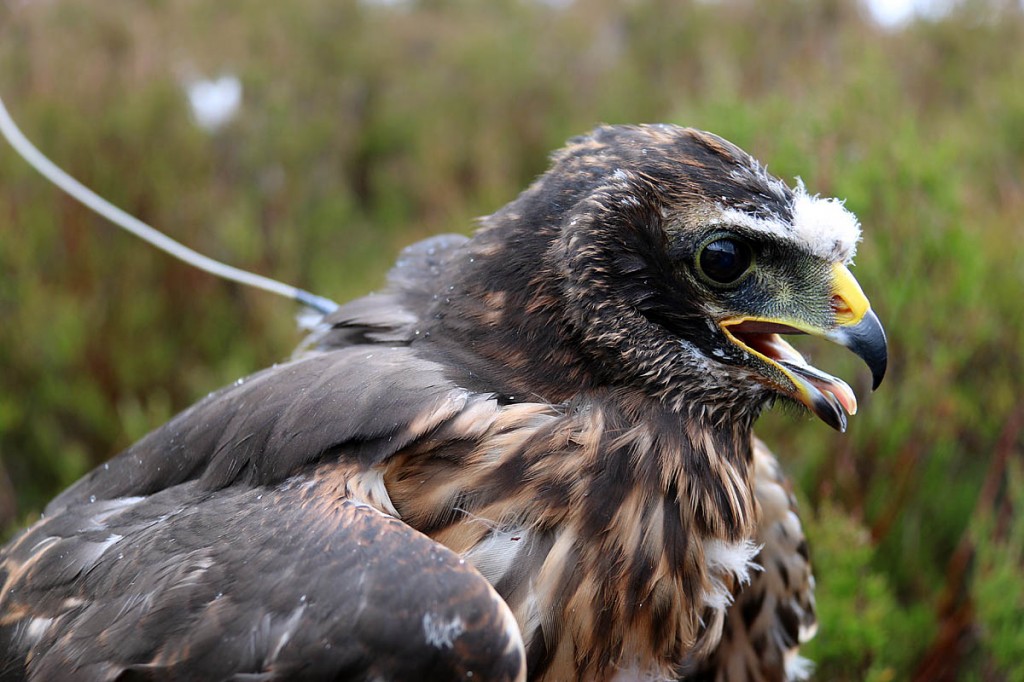The National Trust for Scotland has called for political action after the disappearance of a hen harrier raised on one of its Highland estates.
The charity said Calluna’s satellite tag ceased transmitting after the bird went missing in suspicious circumstances on 12 August north of Ballater.
Her last recorded position was over a grouse moor in the Cairngorms national park. She had fledged from the nest just a month earlier.
She was hatched on the Mar Lodge Estate near Braemar and given her name after a Twitter poll of the public organised by NTS staff.
Calluna’s hatching followed hard work by trust staff and volunteers over many years to restore habitats to make the recovery of populations of various threatened species possible.
The National Trust for Scotland’s operations manager at Mar Lodge David Frew said: “Staff at Mar Lodge Estate and the National Trust for Scotland as a whole are deeply saddened by the apparent loss of Calluna.
“She was the result of only the second successful breeding attempt by hen harriers on the estate in living memory.
“We are not going to let this stop our vital conservation work. We are going to carry on at Mar Lodge and our other properties doing what we can to ensure the survival and recovery of endangered species.
“We will find and work with partners who can help us deliver mutually beneficial land management solutions through which people and nature will thrive together.
“Hen harriers were persecuted on Deeside for a great many years, and we had hoped that the first successful breeding attempt on Mar Lodge Estate in 2016 would signal the start of a recovery for these magnificent birds in the area.
“Only one month after fledging, and having travelled only a relatively short distance, it appears that we will no longer be able to follow the progress of our 2017 chick. We hope however that the data her tag has provided will help to inform a wider understanding of the lives and threats faced by hen harriers.
“The good news is that Harriet, another hen harrier chick we tagged in 2016, and was also named via a public poll, is alive and well, having overwintered in the Lake District and retuned to Mar Lodge Estate in the spring of this year.
“We very much hope that our harriers will return to Mar Lodge Estate to breed again in 2018. In the meantime you can keep watch on Harriet on the Hen Harrier Life project website.”
The National Trust for Scotland’s head of conservation policy, Stuart Brooks said: “If Calluna has been lost, as we fear, it is a sad day for us and Scotland.
“We have worked so hard over recent years to help nature return to the hills and glens of Mar Lodge, affirmed by its recent designation as the British Isles’ largest national nature reserve.
“If Calluna’s fate adds to the body of evidence that raptors are being killed we need the Scottish Parliament to act swiftly and decisively to minimise the risk of this happening again at Mar Lodge and elsewhere.”
Ian Thomson, head of investigations at Royal Society for the Protection of Birds Scotland, said: “This bird joins the lengthening list of satellite-tagged birds of prey that have disappeared, in highly suspicious circumstances, almost exclusively in areas in areas intensively managed for grouse shooting.
“We are pleased that the cabinet secretary for the environment has commissioned an independent group to look at how grouse moors can be managed sustainably and within the law.
“We look forward to a further announcement shortly on the membership of this group, and we are committed to assist the work of this enquiry in any way that we can.
“The Life project team has fitted a significant number of tags to young hen harriers this year, with the very welcome help from landowners, including the National Trust for Scotland, who value these magnificent birds breeding on their property.
“The transmitters used in this project are incredibly reliable and the sudden halt in data being received from it, with no hint of a malfunction, is very concerning. We ask that if anyone has any information about the disappearance of this bird we urge them to contact Police Scotland as quickly as possible.”
RSPB Scotland said hen harriers are one of the UK’s rarest raptors and the 2016 national survey results released earlier this year showed that even in Scotland, the species’ stronghold, these birds are struggling. The number of breeding pairs in Scotland now stands at 460, a fall of 27 per cent since 2004, with illegal killing in areas managed for driven grouse shooting identified as one of the main drivers of this decline.
The grouse shooting season begins on 12 August each year.
